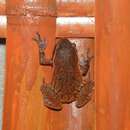fi
nimet breadcrumb-navigoinnissa


Plethodontohyla notosticta zo ur glesker brosezat e Madagaskar.
Plethodontohyla notosticta és una espècie de granota que viu a Madagascar.
Es troba amenaçada d'extinció per la pèrdua del seu hàbitat natural.
Plethodontohyla notosticta és una espècie de granota que viu a Madagascar.
Es troba amenaçada d'extinció per la pèrdua del seu hàbitat natural.
Plethodontohyla notosticta is a species of frog in the family Microhylidae. It is endemic to Madagascar.[2] Its natural habitats are subtropical or tropical moist lowland forests, subtropical or tropical moist montane forests, and heavily degraded former forest. It is threatened by habitat loss.
Plethodontohyla notosticta is a species of frog in the family Microhylidae. It is endemic to Madagascar. Its natural habitats are subtropical or tropical moist lowland forests, subtropical or tropical moist montane forests, and heavily degraded former forest. It is threatened by habitat loss.
Plethodontohyla notosticta es una especie de anfibio de la familia Microhylidae.[2] Es endémica del este de Madagascar donde habita en selvas tropicales entre el nivel del mar y los 1200 metros de altitud. Es una especie terrestre aunque también se encuentra en vegetación baja. No se considera amenazada de extinción aunque su hábitat se está reduciendo debido a la presión humana.[1]
Plethodontohyla notosticta es una especie de anfibio de la familia Microhylidae. Es endémica del este de Madagascar donde habita en selvas tropicales entre el nivel del mar y los 1200 metros de altitud. Es una especie terrestre aunque también se encuentra en vegetación baja. No se considera amenazada de extinción aunque su hábitat se está reduciendo debido a la presión humana.
Plethodontohyla notosticta Plethodontohyla generoko animalia da. Anfibioen barruko Microhylidae familian sailkatuta dago, Anura ordenan.
Plethodontohyla notosticta Plethodontohyla generoko animalia da. Anfibioen barruko Microhylidae familian sailkatuta dago, Anura ordenan.
Plethodontohyla notosticta est une espèce d'amphibiens de la famille des Microhylidae[1].
Cette espèce est endémique de l'Est de Madagascar. Elle se rencontre dans l'est de l'île entre le Sud du mont Marojejy et le parc national d'Andohahela et, dans l'Ouest, du Parc national Tsingy de Bemaraha jusqu'aux environs d'Ambohijanahary. Elle est présente du niveau de la mer jusqu'à 1 200 m d'altitude[1],[2].
Plethodontohyla notosticta mesure entre 35 et 42 mm. Son dos varie du brun roux au brun sombre parfois avec des stries brun foncé. Une fine ligne blanche marque la séparation entre le dos et les flancs qui sont uniformément sombre. La peau de son dos est lisse. Son ventre est blanchâtre ou jaunâtre parfois avec des taches sombres au niveau de la gorge qui peut être entièrement sombre chez le mâle[3].
Les têtards mesurent jusqu'à 17 mm et les jeunes font 6 mm lors de la métamorphose.
Plethodontohyla notosticta est une espèce d'amphibiens de la famille des Microhylidae.
Plethodontohyla notosticta é uma espécie de anfíbio da família Microhylidae.
É endémica de Madagáscar.
Os seus habitats naturais são: florestas subtropicais ou tropicais húmidas de baixa altitude, regiões subtropicais ou tropicais húmidas de alta altitude e florestas secundárias altamente degradadas.
Está ameaçada por perda de habitat.
Plethodontohyla notosticta é uma espécie de anfíbio da família Microhylidae.
É endémica de Madagáscar.
Os seus habitats naturais são: florestas subtropicais ou tropicais húmidas de baixa altitude, regiões subtropicais ou tropicais húmidas de alta altitude e florestas secundárias altamente degradadas.
Está ameaçada por perda de habitat.
Plethodontohyla notosticta là một loài ếch trong họ Nhái bầu. Chúng là loài đặc hữu của Madagascar. Các môi trường sống tự nhiên của chúng là các khu rừng ẩm ướt đất thấp nhiệt đới hoặc cận nhiệt đới, các khu rừng vùng núi ẩm nhiệt đới hoặc cận nhiệt đới, và các khu rừng trước đây bị suy thoái nặng nề. Loài này đang bị đe dọa do mất môi trường sống.
Phương tiện liên quan tới Plethodontohyla notosticta tại Wikimedia Commons
Plethodontohyla notosticta là một loài ếch trong họ Nhái bầu. Chúng là loài đặc hữu của Madagascar. Các môi trường sống tự nhiên của chúng là các khu rừng ẩm ướt đất thấp nhiệt đới hoặc cận nhiệt đới, các khu rừng vùng núi ẩm nhiệt đới hoặc cận nhiệt đới, và các khu rừng trước đây bị suy thoái nặng nề. Loài này đang bị đe dọa do mất môi trường sống.